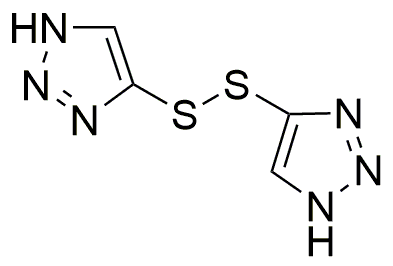4,4'-Di(1,2,3-triazolyl) disulfide is widely utilized in research focused on:
- Antimicrobial Agents: This compound is effective in developing new antimicrobial agents, offering a potential solution to antibiotic resistance in healthcare.
- Polymer Chemistry: It serves as a cross-linking agent in polymer synthesis, enhancing the mechanical properties of materials used in coatings and adhesives.
- Analytical Chemistry: The compound is used in the development of sensors for detecting heavy metals and other pollutants, contributing to environmental monitoring efforts.
- Pharmaceutical Development: It plays a role in drug formulation, particularly in creating targeted delivery systems that improve the efficacy of therapeutic agents.
- Bioconjugation: This chemical is valuable in bioconjugation processes, facilitating the attachment of biomolecules to surfaces, which is crucial in diagnostics and biosensors.
Información general
Propiedades
Seguridad y normativas
Aplicaciones
4,4'-Di(1,2,3-triazolyl) disulfide is widely utilized in research focused on:
- Antimicrobial Agents: This compound is effective in developing new antimicrobial agents, offering a potential solution to antibiotic resistance in healthcare.
- Polymer Chemistry: It serves as a cross-linking agent in polymer synthesis, enhancing the mechanical properties of materials used in coatings and adhesives.
- Analytical Chemistry: The compound is used in the development of sensors for detecting heavy metals and other pollutants, contributing to environmental monitoring efforts.
- Pharmaceutical Development: It plays a role in drug formulation, particularly in creating targeted delivery systems that improve the efficacy of therapeutic agents.
- Bioconjugation: This chemical is valuable in bioconjugation processes, facilitating the attachment of biomolecules to surfaces, which is crucial in diagnostics and biosensors.
Documentos
Hojas de datos de seguridad (HDS)
La SDS proporciona información de seguridad completa sobre la manipulación, el almacenamiento y la eliminación del producto.
Especificación del producto (PS)
La PS proporciona un desglose completo de las propiedades del producto, incluida la composición química, el estado físico, la pureza y los requisitos de almacenamiento. También detalla los rangos de calidad aceptables y las aplicaciones previstas del producto.
Certificados de análisis (COA)
Busque certificados de análisis (COA) ingresando el número de lote del producto. Los números de lote y de partida se pueden encontrar en la etiqueta de un producto después de las palabras "Lote" o "Lote".
Número de catálogo
Número de lote/lote
Certificados de origen (COO)
Este certificado de origen confirma el país en el que se fabricó el producto y también detalla los materiales y componentes utilizados en él y si se deriva de fuentes naturales, sintéticas u otras fuentes específicas. Este certificado puede ser necesario para cumplir con las normativas aduaneras, comerciales y regulatorias.
Número de catálogo
Número de lote/lote
Hojas de datos de seguridad (HDS)
La SDS proporciona información de seguridad completa sobre la manipulación, el almacenamiento y la eliminación del producto.
DownloadEspecificación del producto (PS)
La PS proporciona un desglose completo de las propiedades del producto, incluida la composición química, el estado físico, la pureza y los requisitos de almacenamiento. También detalla los rangos de calidad aceptables y las aplicaciones previstas del producto.
DownloadCertificados de análisis (COA)
Busque certificados de análisis (COA) ingresando el número de lote del producto. Los números de lote y de partida se pueden encontrar en la etiqueta de un producto después de las palabras "Lote" o "Lote".
Número de catálogo
Número de lote/lote
Certificados de origen (COO)
Este certificado de origen confirma el país en el que se fabricó el producto y también detalla los materiales y componentes utilizados en él y si se deriva de fuentes naturales, sintéticas u otras fuentes específicas. Este certificado puede ser necesario para cumplir con las normativas aduaneras, comerciales y regulatorias.


